Property Description and Ownership
Paiute is located in northern Nevada, approximately 6.5 miles west of Battle Mountain near the northern end of the Battle Mountain-Eureka Trend, one of Nevada’s prolific mineral belts. The project area sits within the Battle Mountain mining district and covers approximately 1,343 acres in a total of 65 unpatented Bureau of Land Management (BLM) mining claims.
Infrastructure is excellent at the project site with interstate highway and railroad immediately adjacent to the property, and high voltage power to the immediate north.
Timberline is the operator of the JV. There are no earn-in work expenditure requirements.
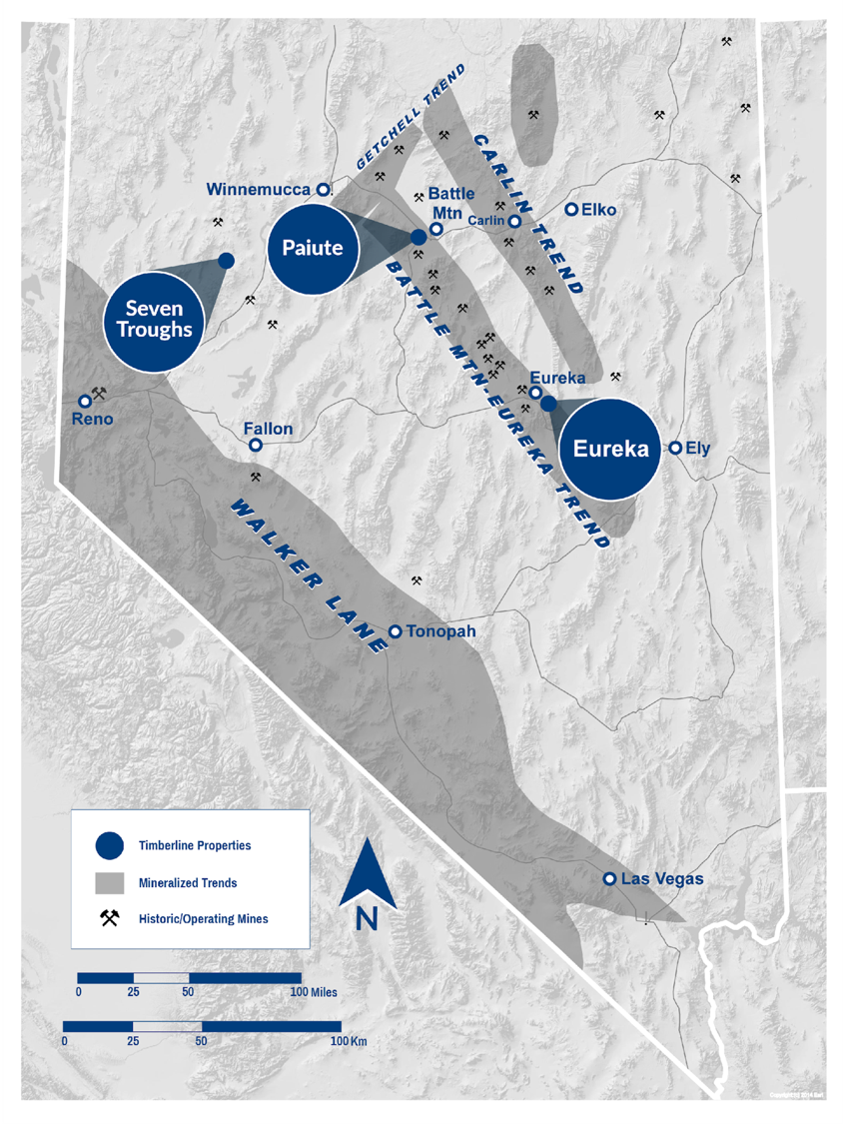
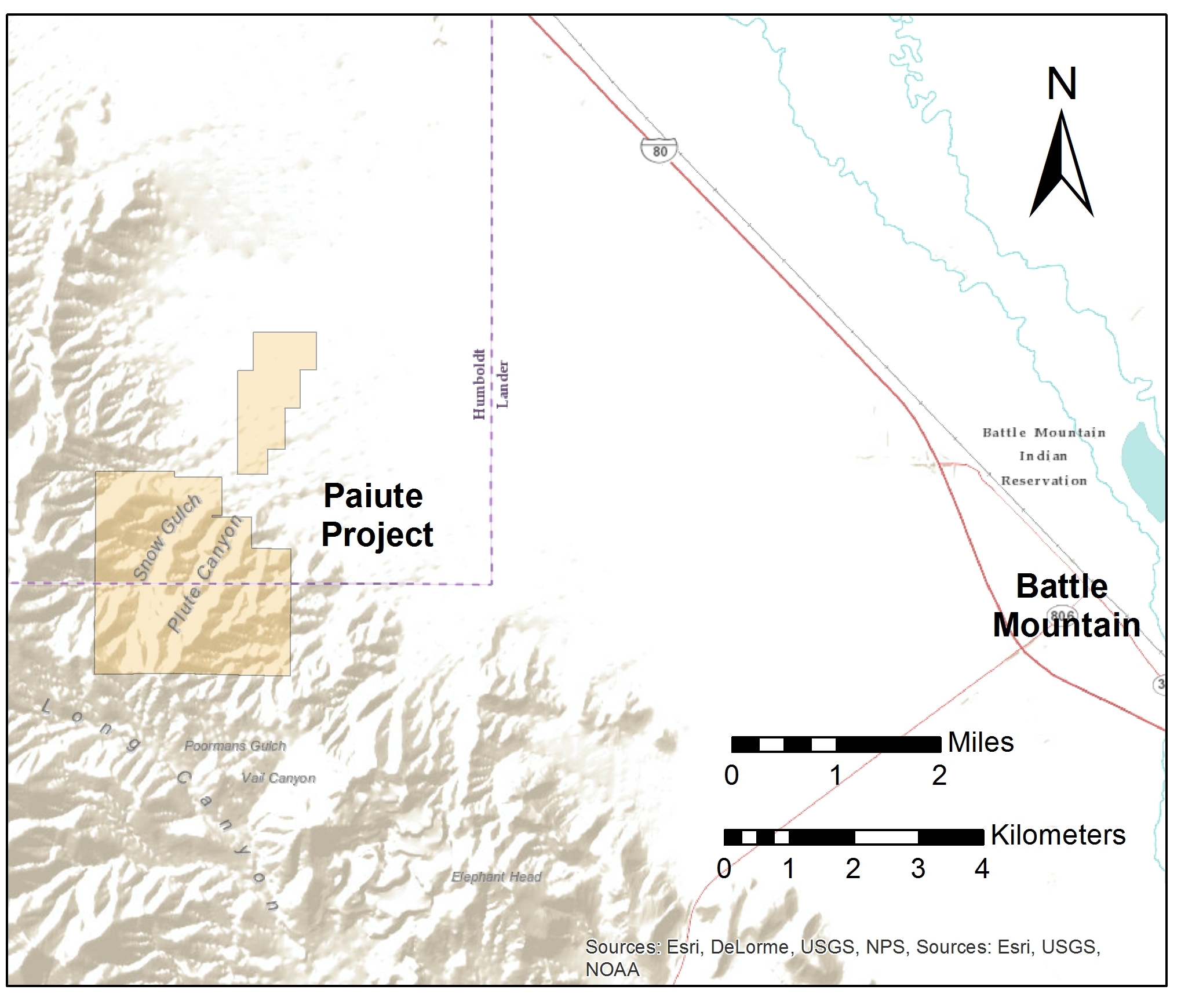
Exploration and Mining History
The Battle Mountain district has been a source of base and precious metal production since the late 1800’s. Several companies have explored and/or developed mines in the district since the 1960s including: Duval Corporation, Battle Mountain Gold Company, LAC Minerals, Pathfinder Exploration and Newmont.
The Battle Mountain mining district currently includes 3 producing mines and 1 copper-gold development project including:
- Newmont’s
- Lone Tree Gold Mine
- Phoenix Gold & Copper Mine
- Copper Basin Copper-gold development
- SSR Mining’s Marigold Mine Complex
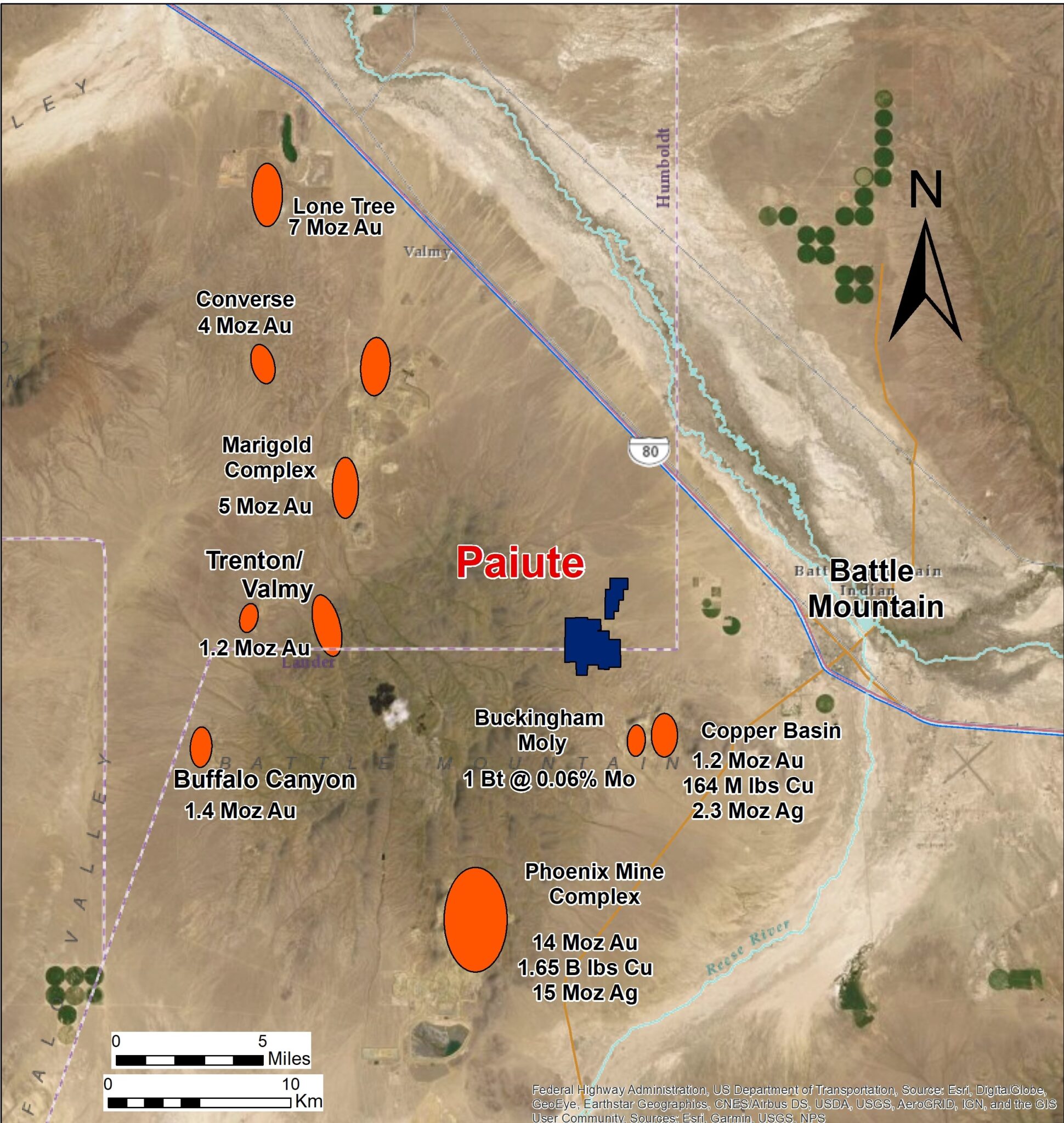
Geology
In the western part of the Paiute area, the Dewitt Thrust Fault places Ordovician Valmy Formation cherts and shales on top of Cambrian Harmony Formation quartz- and feldspathic-sandstones and shales, which are locally calcareous. Faults at Elder Creek dip steeply, strike north-northwest to north-northeast and show normal and oblique-slip offset. The Elder Creek Fault indicates normal, down-to-the- west movement.
Generalized Geology of the Battle Mountain Area
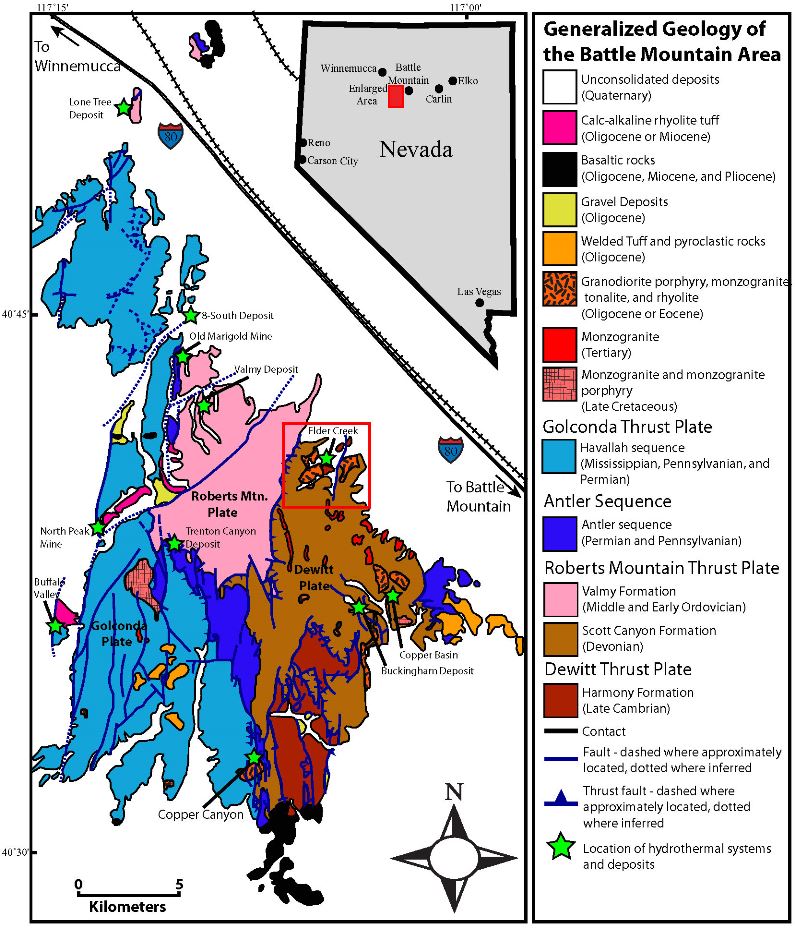
In the Paiute area, the Harmony Formation is intruded by seven Cretaceous to Tertiary age felsic porphyritic intrusives as high level plugs, stocks, dikes and sills. Thermal metamorphism associated with the intrusions produced hornfels, quartzite and skarn in the Harmony Formation sediments.
A series of en echelon structures and sub-parallel faults define a strong N 10-20° E – striking structural zone through the central part of the property that extends approximately 16,500 feet in length and up to 1,500 feet in width. Secondary northwest and north-striking faults cut the northeast-striking structures. Locally, the structures are occupied by granodiorite porphyry dikes. The structures are typically altered and mineralized.
Hydrothermal alteration associated with the intrusions consists of argillization, silicification, and quartz veining/stockworks that are accompanied by zones of hydrous iron oxides as fracture fillings, disseminations, and occasional gossans. Chlorite + actinolite occur locally within quartz veins. Quartz veining occurs throughout the project area and increases in intensity within the alteration zones.
Geology of the Paiute Area
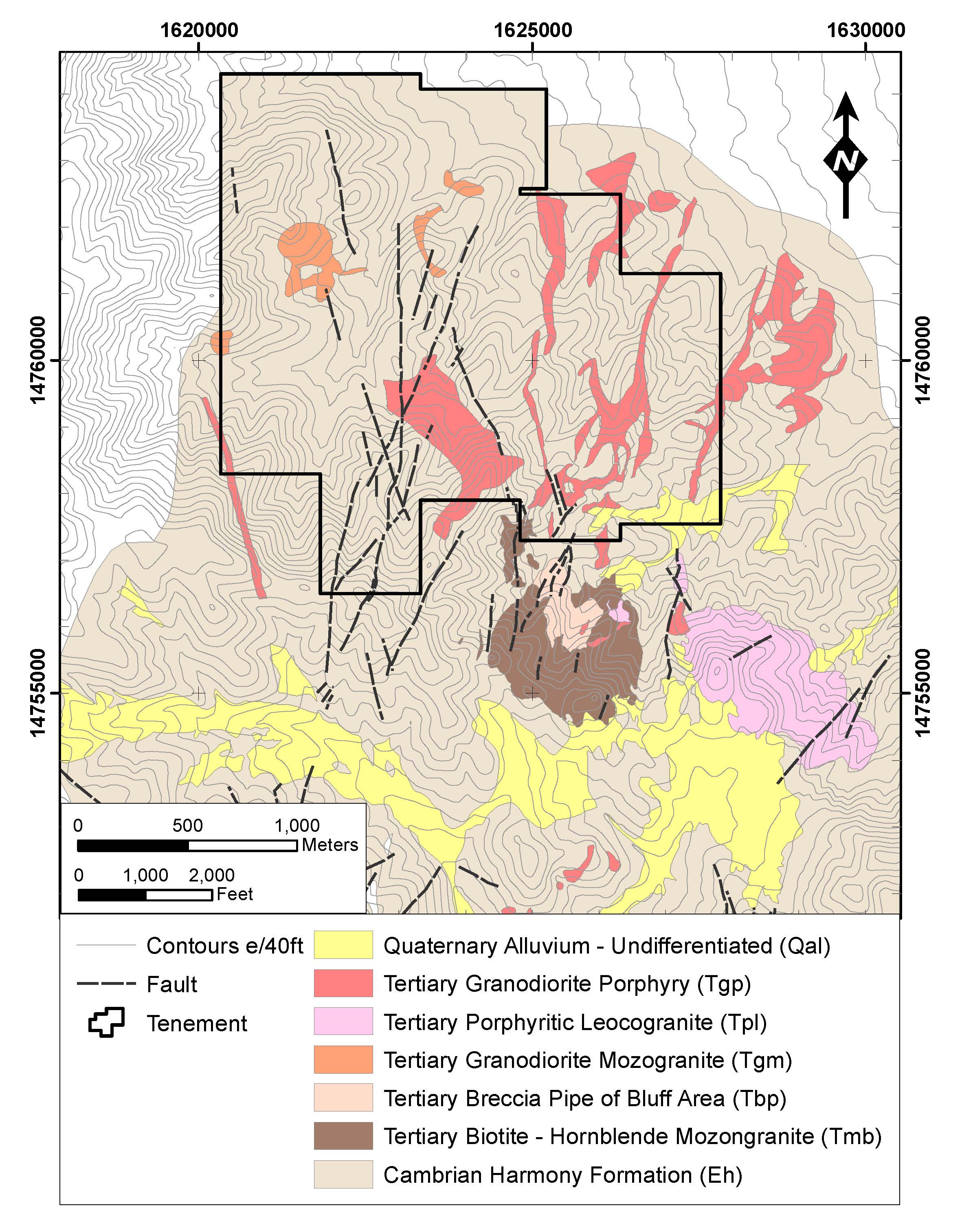
Geology of the Paiute Area with Outer Limits of Hornfels and Quartz Stockworks
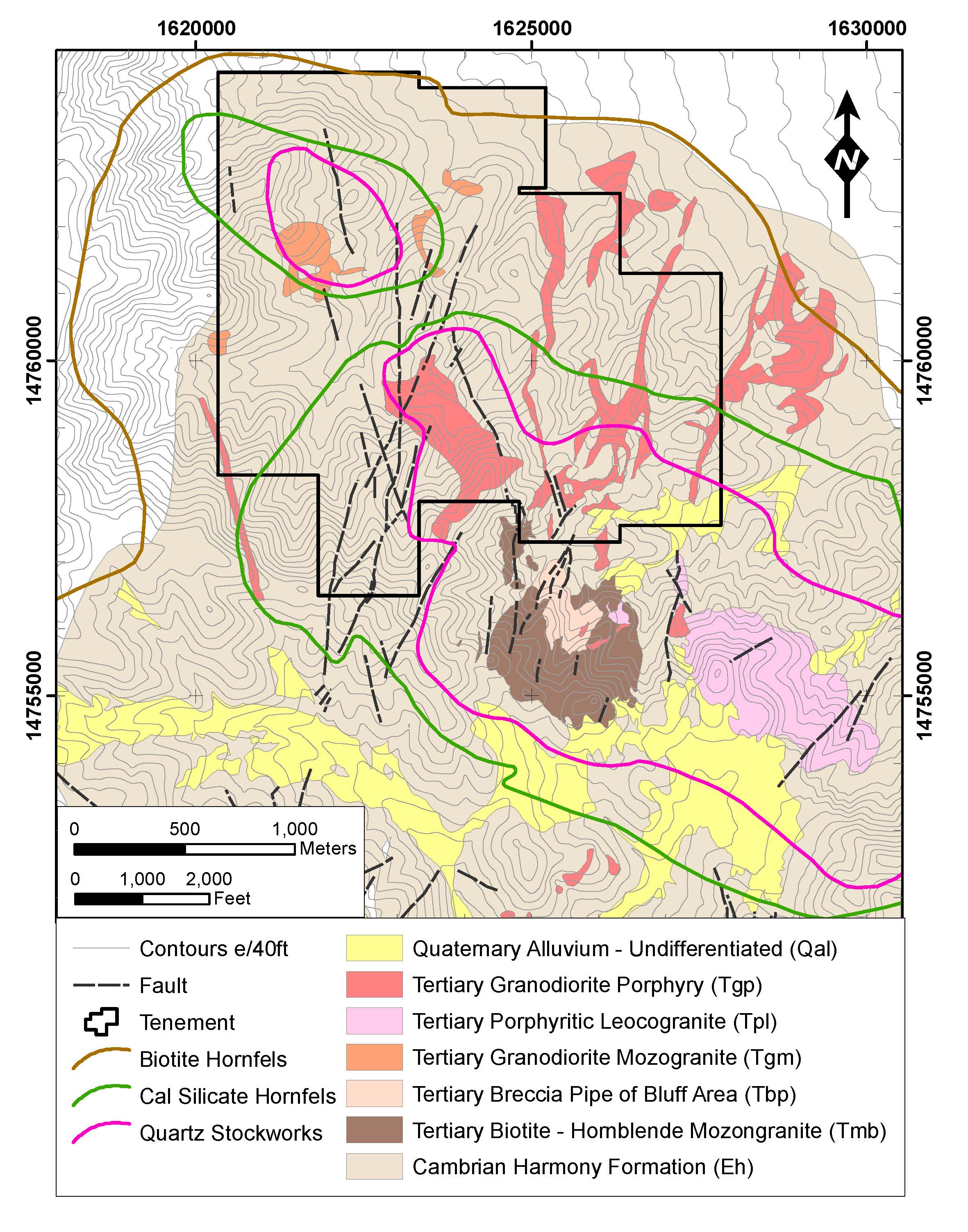
Geophysics
Total field magnetics shows a strong donut-shaped magnetic anomaly at Paiute. These features are similar to those at many porphyry copper deposits. The cause of the magnetic high has not been documented in the Paiute project area.
Historic Total Field Magnetics for the Paiute Project Area
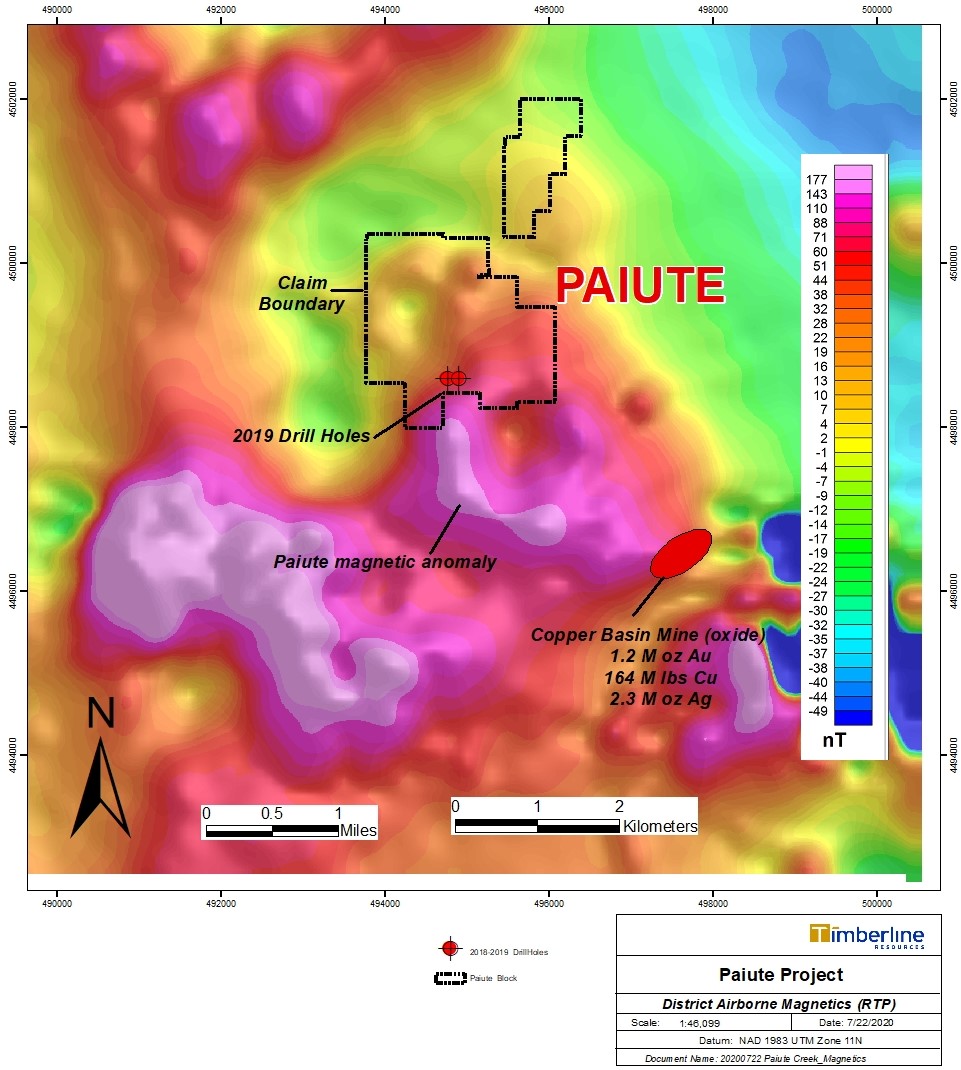
Geochemistry
The major trend of gold mineralization at Paiute is definable from soil and rock data along the N10°-20°E structural zone and fault-controlled quartz-sericite-pyrite alteration that extends through the center of the project area. There is a moderate spatial correlation between gold, silver and arsenic within the structural zone. A large area of anomalous silver also occurs in the south-central part of the claim block.
Gold, Silver, and Arsenic Anomalies in Rocks and Soils
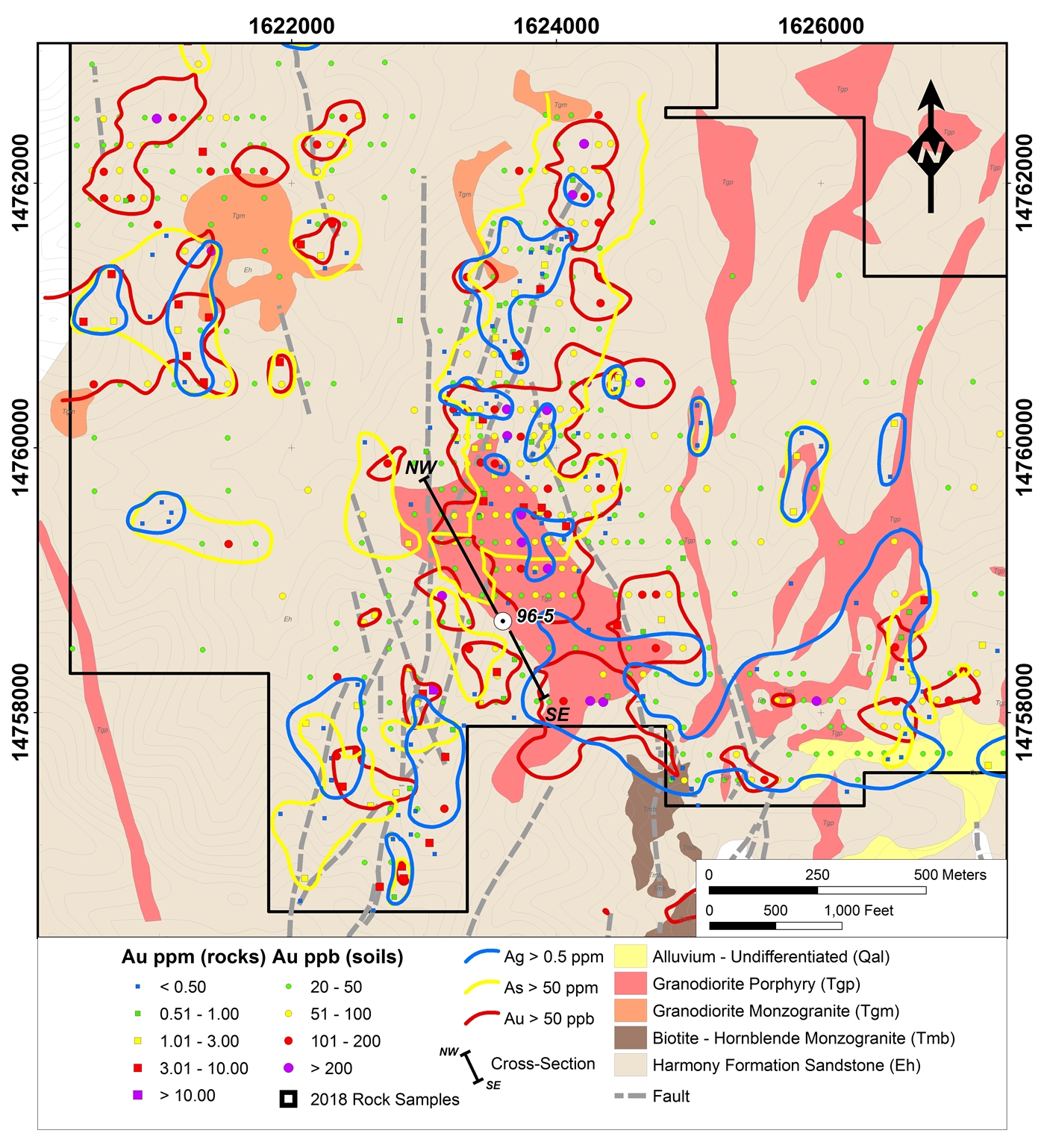
Copper is anomalous primarily in the southeast part of the property block and has been noted in historic drillhole 96-5.
Copper and Molybdenum Anomalies in Rocks and Soils
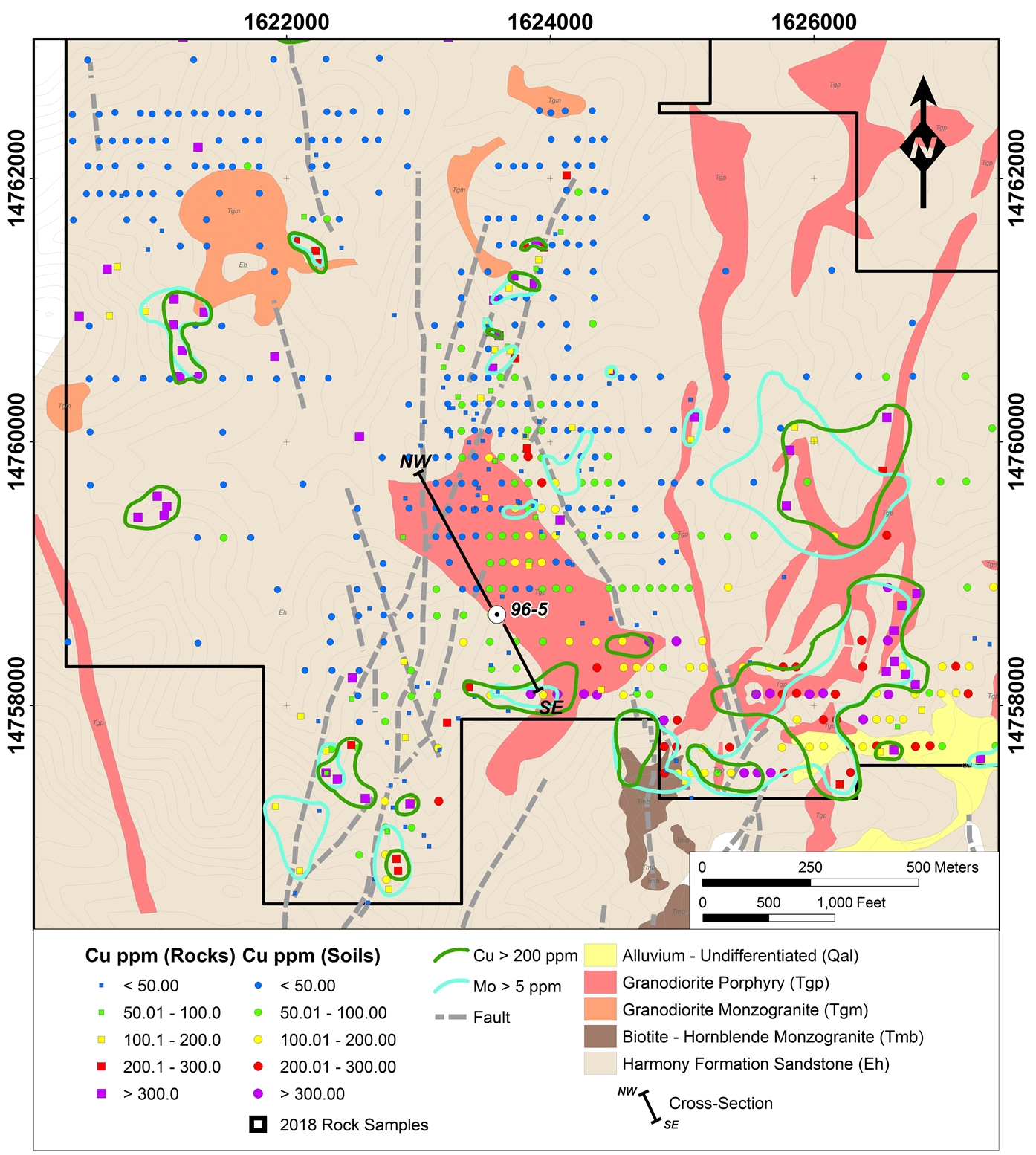
Drilling
Approximately 40 historic drill-holes were completed in the Paiute area focused on the gold-bearing vein systems within the northeast-trending structural zone. The majority of the holes were shallow (less than 570 ft (150 m)); many intercepted gold mineralization as noted below.
Battle Mountain Gold Drill-hole Intercept Highlights
| Drill Hole |
Interval |
Thickness Feet |
Au oz/ton (g/t) |
| BM 3206 | 210 – 279 | 69 | 0.014 (0.479) |
| BM 3632 | 0 – 100 | 98 | 0.027 (0.924) |
| 351 – 400 | 49 | 0.016 (0.548) | |
| BM 3899 | 10 – 180 | 170 | 0.020 (0.685) |
| 95 – 161 | 66 | 0.012 (0.411) | |
| BM 4006 | 246 – 298 | 52 | 0.015 (0.514) |
In addition, a drill program by Pathfinder in 1995 intersected porphyry gold-copper mineralization in drill hole 96-5. Drill hole 96-5 was located along the southeast edge of the N10-20°E structural zone (Figures 9-1, 9-2, 9-4) and was drilled to a depth of 590 ft (176.8 m) (Figure 9-5). The vertical hole intersected quartz monzonite porphyry at 525 ft (160 m) depth (Figure 9-5) with gold and copper mineralization noted.
Follow-up petrographic work by Larson (1996) identified a silicified, sulfidic (pyrite, chalcopyrite), quartz/calcite veined zone of quartz monzonite porphyry, Cambrian sandstone/quartzite (Harmony Formation) and diabase, along with a skarn dominant monzonite or granodiorite porphyry with “significant percentages of pyrite, chalcopyrite, and chalcocite”. A zone at the bottom of the hole contained a sericitized, chloritized, amphibole rich quartz monzonite porphyry with secondary biotite. The last 15 ft (4.6 m) of the hole averaged 0.035 oz/t Au (1.24 g/t) and is accompanied by increased silicification and sulfides (chalcopyrite, pyrite, arsenopyrite).
Historic Drill Holes in the Paiute Project Area
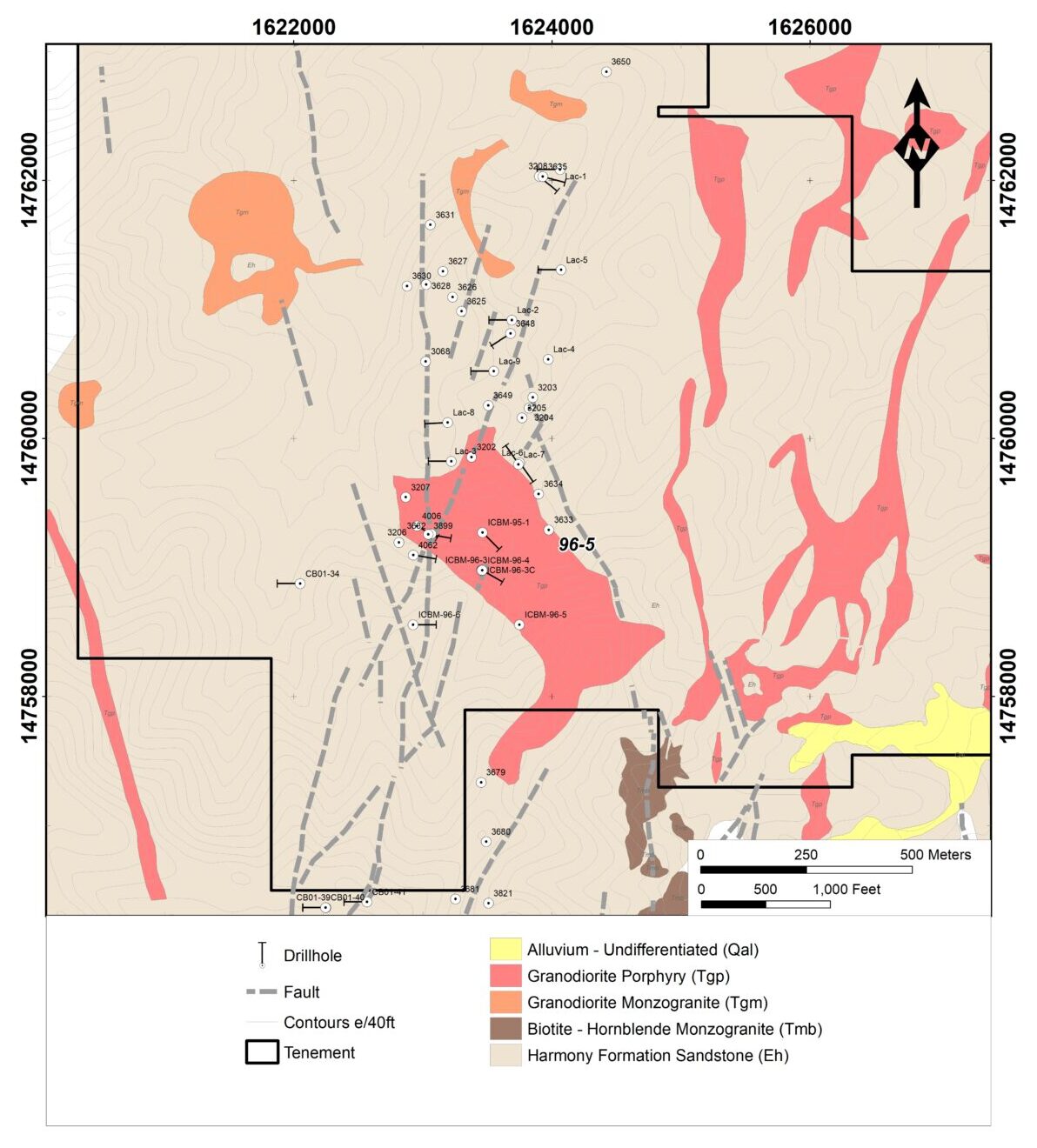
Timberline Drilling
In 2019, Timberline completed two drill holes at the Paiute project and intercepted long intervals of disseminated gold mineralization in granodiorite porphyry and contact metamorphosed sandstone. Both reverse circulation (RC) holes were terminated in mineralized, hard, silicified rock because of limitations of the drill rig. Two distinct styles of gold mineralization were intercepted on two distinct targets.
Gold-Silver Structural Zone Target: PCRC 19-01 intercepted 125 feet (ft) (38 meters (m)) grading 0.36 g/t Au with associated pyrrhotite-pyrite-arsenopyrite in silicified, metamorphosed arkosic sandstone. The hole bottomed in silicified granodiorite porphyry with geochemical characteristics similar to that of PCRC19-02 (see Table below).
Gold Porphyry Target: PCRC 19-02 twinned and deepened historical hole ICBM-95-06 and intercepted multiple zones of gold mineralization in granodiorite porphyry and metamorphosed arkosic sandstone, including 40 ft (12 m) of 0.61 g/t, 80 ft (24 m) of 0.51, 25 ft (8 m) of 1.12 g/t, and 25 ft (8 m) of 0.48 g/t over its 710 feet (216 m) length; the hole bottomed in mineralization. The host rocks to the gold porphyry-style mineralization are highly silica-altered, and sulfide-poor (trace – 1% pyrite). The mineralization in PCRC 19-02 expands on multiple intercepts in nearby historic holes.
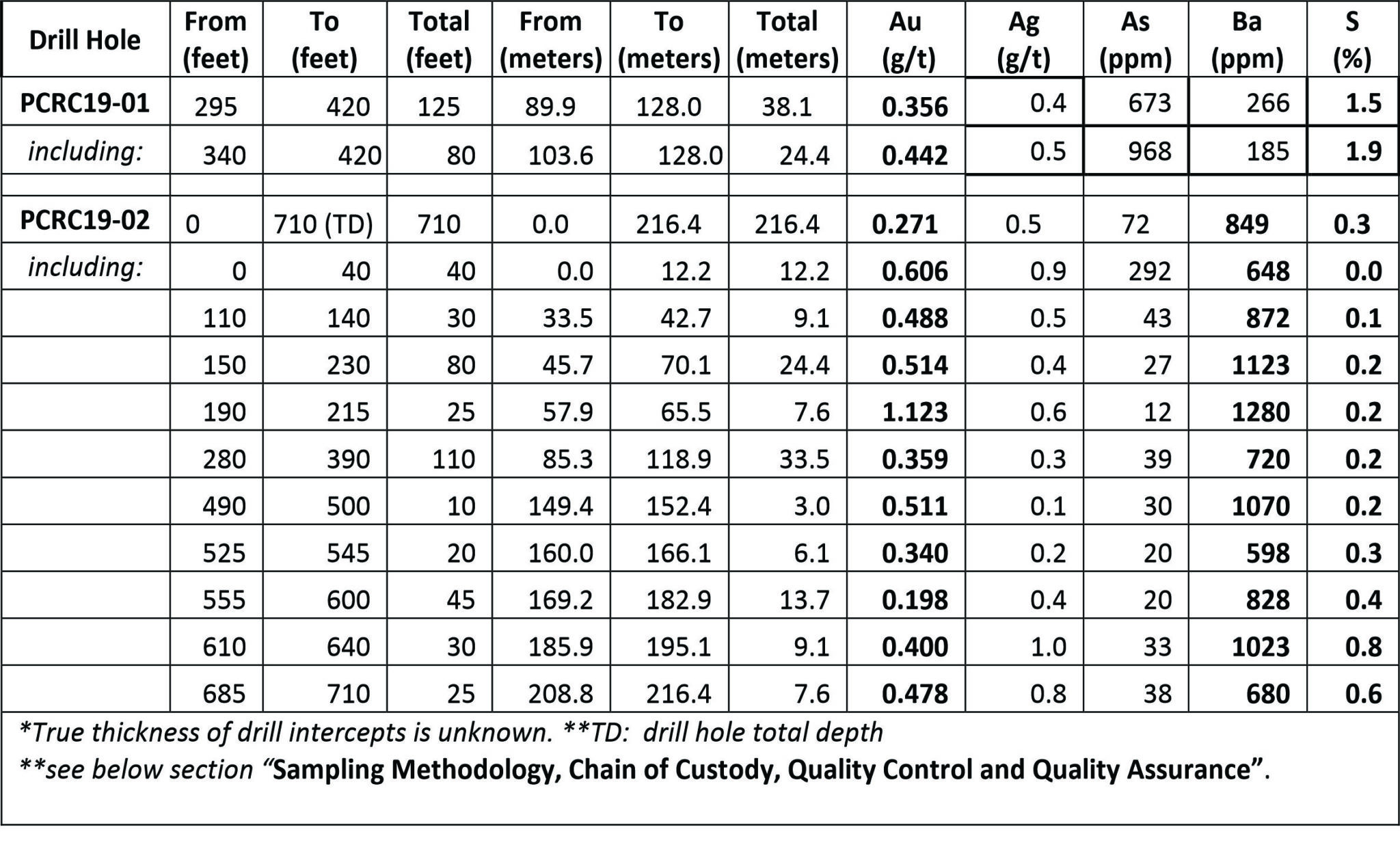
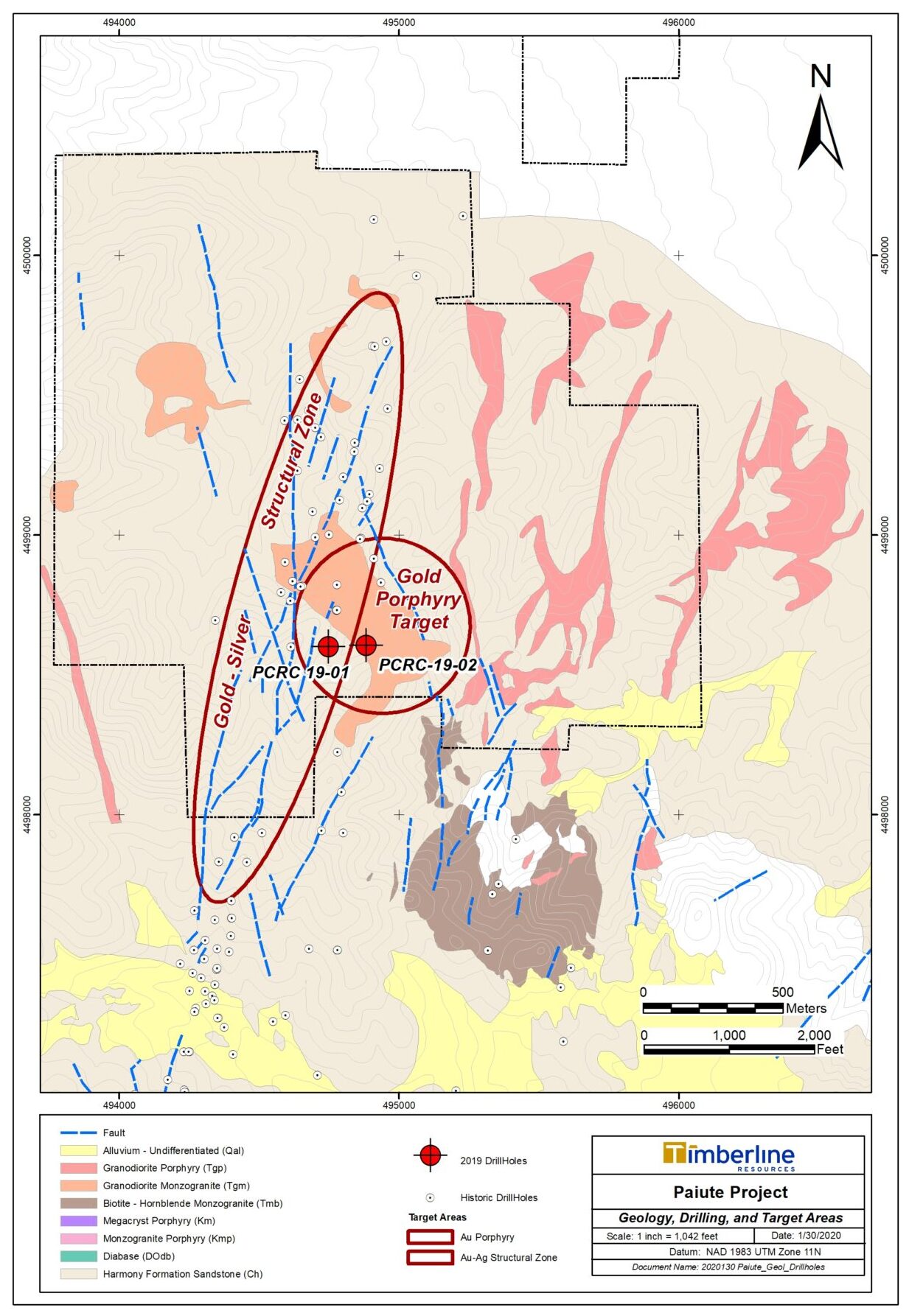
Schematic Cross-Section around Drill Hole PCRC 19-02
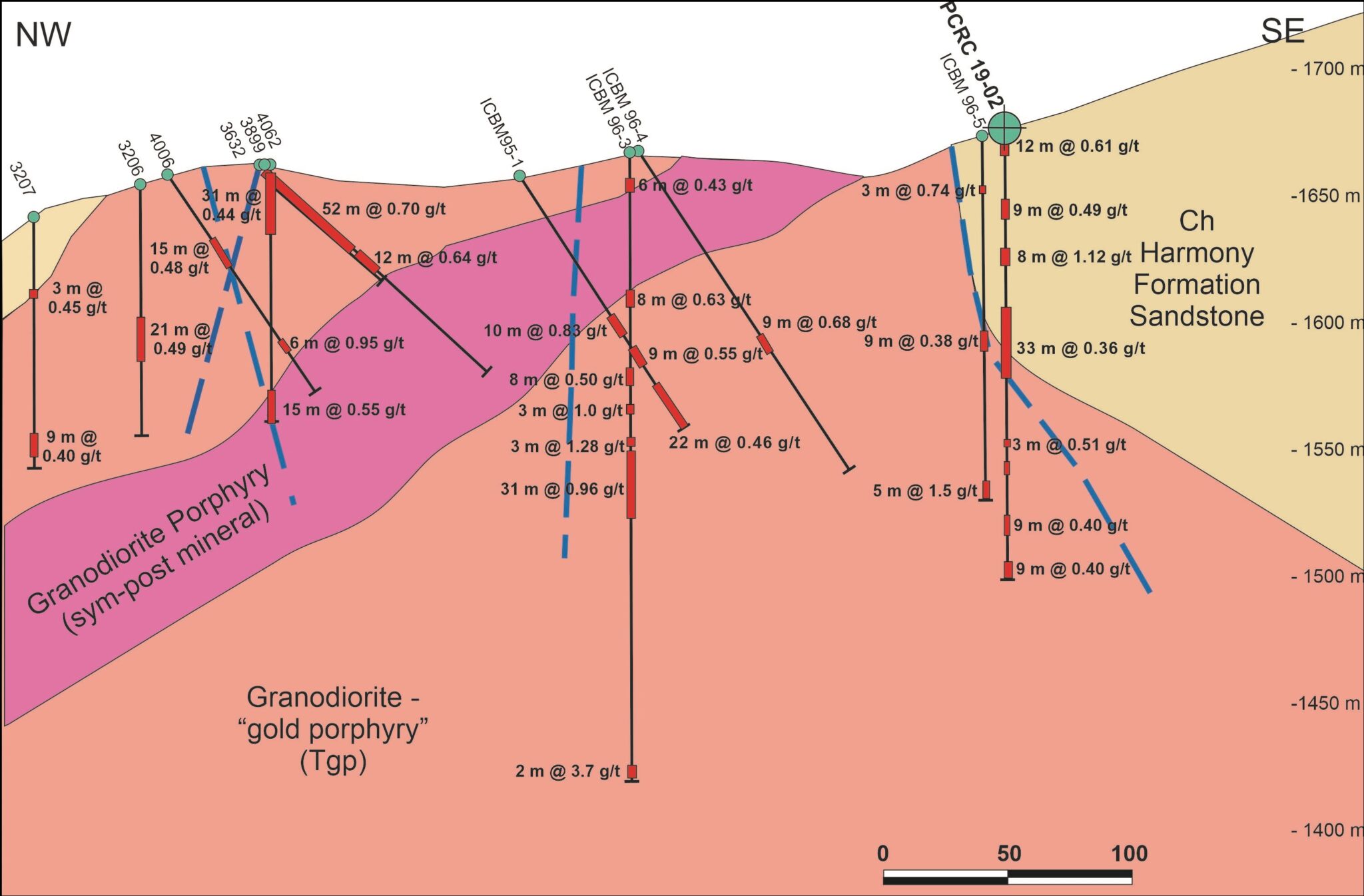
Exploration Plans
The Paiute project has the potential to host bulk-mineable, open-pit gold mineralization based on the thicknesses and grades drilled to date. The Company is acquiring historical IP/Resistivity, and magnetic survey data to guide future drilling of the largely untested structural zone and porphyry targets.
